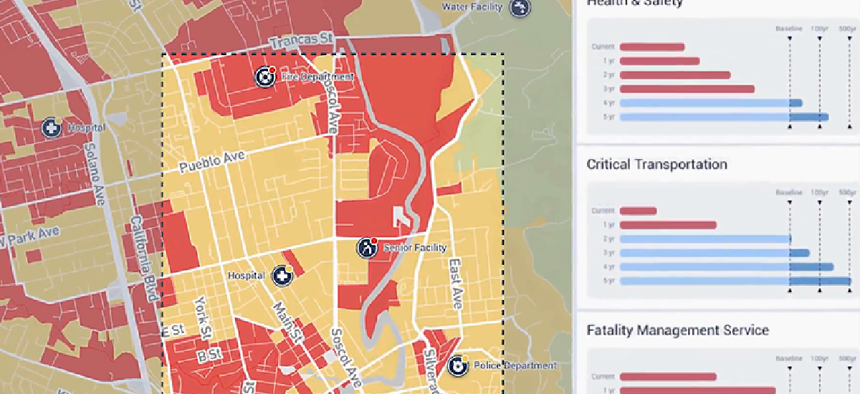AI-based damage predictions for disaster response


Connecting state and local government leaders
The One Concern platform aims to deliver hyper-local damage assessments within 30 minutes.
Following the deadliest and most destructive wildfire in California’s history, a company is building an artificial intelligence- and machine learning-based technology that aims to help firefighters, first responders and local officials better respond to fires.
One Concern, a California-based company, expects to launch Fire Concern in early 2019. Initially, it will give users a specialized map showing a fire's location and update that information about every 15 minutes to help responders see where to deploy firefighting resources and order evacuations. Building from there, the tool would predict where fires may go and what potential steps authorities can take to mitigate the effects of fires before they occur.
Fire Concern is the company's latest effort, following the development of Flood Concern and Seismic Concern, AI applications targeting flood and earthquake response.
The technology assigns a unique identifier to natural and manmade elements and combines that information with data on the buildings' materials and soil properties where they are located. It adds in data on the resident population, critical infrastructure and evacuation routes along with the interdependencies of health care, power, food and shelter to evaluate near real-time impacts. After an event occurs, the system incorporates information from responders and best practices to make its predictions more accurate.
Officials get near-real-time situational awareness, at the block level, on the likelihood of damage and the impact on the community. With that hyper-local information, even people without training in seismology or structural engineering can easily do damage modeling that will help them prepare for disaster response and develop resiliency plans.
To help predict flooding, for example, users could run a simulation, "put in a flood wall and then run the floods again and see what changes," Craig Fugate, One Concern's chief emergency management officer and former administrator of the Federal Emergency Management Agency said in a video. For earthquakes, the system has been able predict with "high probability what the impacts were within 20 minutes," he said.
Right now, it’s tough for emergency managers to know where a fire is going to spread, said Ben Colombo, a spokesman for One Concern. "Essentially the technology that emergency managers are grappling with right now is the 911 system -- people calling in and saying, 'I see smoke,' 'I see a red glow,' 'There’s a fire in my backyard,'" he said. Officials at headquarters along with firefighters in the field are all trying to plot locations on maps. “These are people that are doing their absolute best, doing amazing work, and they’re just not armed with a full picture of what’s going on,” he said.
It's common to see traffic-light color coded disaster response maps showing affected areas highlighted in red, Colombo said.
“When you look at our tool, what you’re seeing is not a big red blob but more of a checkerboard-type thing where one block might be red for high damage,” Colombo said. “The block next to it could be yellow, etc. That enables an emergency manager very quickly in the aftermath of a disaster to say, ‘I think these areas are likely to be damaged. I don’t know for certain. This is a prediction’ – we’re very clear about that.”
One Concern overlays its prediction data with demographic information so that responders can see at a glance whether vulnerable populations such as senior citizens are affected.
The software-as-a-service tools collect information from various sources, such as publicly available data on buildings’ construction and natural environment data such as faults and floodplains and what soil conditions are like at a given time. The third data source is live data from, say, the U.S. Geological Survey or weather forecasts when a disaster strikes.
“It identifies potential issues going forward, before they happen, and if I know that, or I know that there is going to be an issue, whether it’s roadways, structures, things to do with the life threat to people, I can prepare for that,” said Daniel Ghiorso, fire chief for the Woodside, Calif., Fire Protection District, in a One Concern video.
One Concern’s products make predictions that aim to be 75 percent accurate in terms of estimating damage to buildings, and that accuracy will increase over time as the tools learn, for instance, that a building sustained less damage than predicted using updated data from inspectors and responders.
If one building sustained less damage than predicted from an earthquake, it’s likely that similar buildings responded the same way, for example, Colombo said. As a result, the system will update predictions for all like buildings, making the system smarter.
“We’re not going to tell you when an earthquake is going to occur. We’re going to tell you what an earthquake is going to do to a city,” he said. “Our goal is to get our customers initial, high-degree-of-accuracy, hyper-local damage predictions in the event of an earthquake within 30 minutes.”
The company currently monitors more than 12 million residential and 652,000 commercial buildings, for earthquakes that could affect 36 million people.
Pricing is based on the population served, not the number of users. The company intends for the products to be used for training and preparation in addition to response when a disaster happens. By running simulations, officials can see gaps in various response scenarios and address them.
Other companies using AI for disaster response include Geospiza, which “filters, relates, integrates, analyzes, and consolidates endless raw data into comprehensive consequence-projections and clear pathways to action,” according to its website, and Microsoft, which announced in September 2018 the AI for Humanitarian Action initiative, a $40 million, five-year plan with several focuses, including disaster response.




